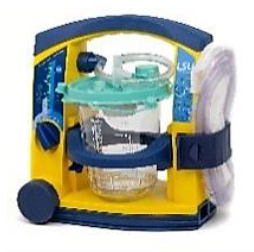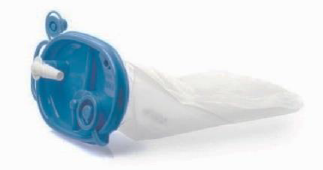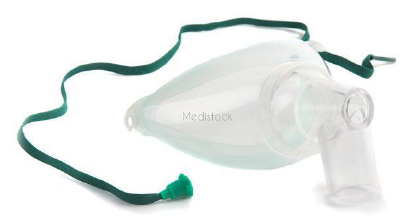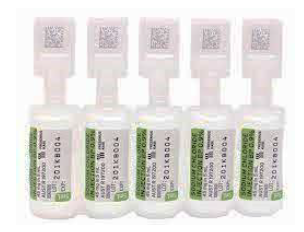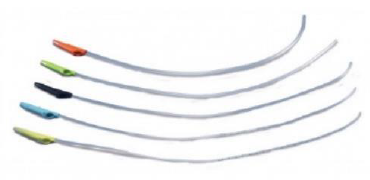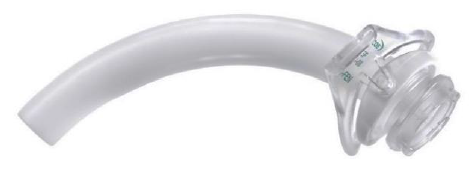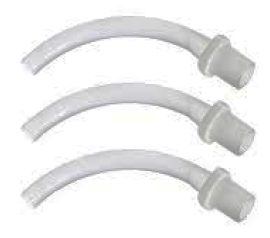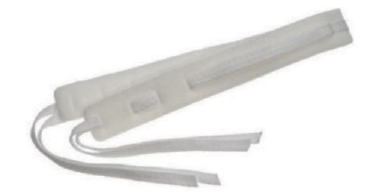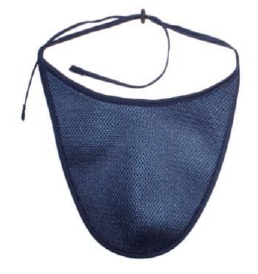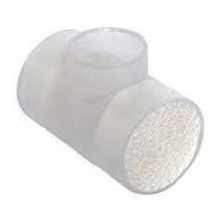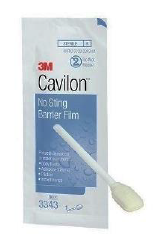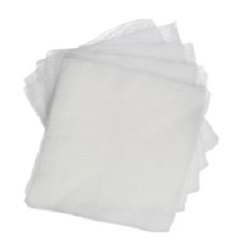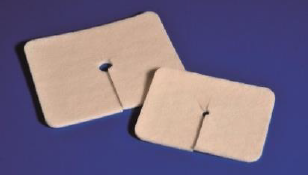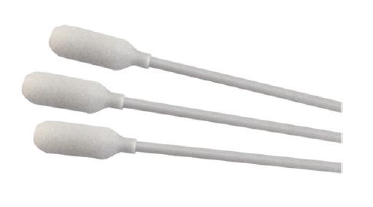Caring for my Tracheostomy
The aim of this booklet is to provide you or those caring for you with the necessary information to feel confident in caring for your tracheostomy. There is a lot of information which we have tried to simplify by grouping into sections.
On this page
Tracheostomy equipment
You will have been given a large range of equipment which should be recognisable to you prior to discharge. If you are not confident in what they are and how they work please ask.
Caring for the stoma
It is important to keep the skin around your stoma (the hole in your neck) healthy.
You will need to wash the stoma daily using a piece of gauze which has been dampened with tap water. Take care not to get water into the actual stoma as this may cause you to cough.
After washing, use a Cavilon™ stick to wipe the skin surrounding the stoma. Cavilon™ provides a barrier between the skin and the secretions coming out of the stoma, preventing the skin becoming sore.
Next, place a dressing around the stoma and underneath the tracheostomy ties. This will soak up any secretions from the stoma. This dressing must be changed daily or more often if it is wet.
Changing the neck ties
The neck ties hold the tracheostomy tube in place to stop it falling out when coughing or moving. They do not need to be tight - you should be able to put 2 fingers underneath. Any excess length can be cut off before securing the ties.
The neck ties should be changed at least twice a week, and more often if they become contaminated with fluids.
To change the neck ties, make sure you have someone there to help you hold the tracheostomy tube while hooking the ties on either side of the tracheostomy. When holding the tracheostomy in place do not cover the hole as you need to allow air to continue to enter the tube.
If you notice any skin damage around the stoma such as dryness, redness, pain or stickiness, this can be a sign of infection so please contact a healthcare professional for further advice.
Air filtration
A tracheostomy allows air to pass directly into the trachea (wind pipe) instead of through your nose and mouth. This means the air does not get warmed or cleaned in the usual way. To compensate for this, a heat-moisture exchange device (HME) is worn on the end of the tracheostomy tube to filter the air breathed in. The HME also prevents your airway from becoming dry. This is important because it reduces coughing and keeps secretions thin. Thin secretions move along the tube easily and are easier to clear or cough out. Regular nebuliser use with normal saline (sterile salty water) also helps thin the secretions and makes it easier to cough out the secretions from the tube.
This HME must be replaced daily to make sure the filter is clean and should only be worn during the day. At night the HME device needs to be removed and a Buchanan® bib worn to help keep secretions from getting thick and prevent the airway from becoming dry.
Secretion management
When you feel secretions in your airway, try to cough to remove them first and use a nebuliser with normal saline. If you cannot cough up these secretions then you may need to use suction.
While on the ward, you will be shown how to perform deep suctioning to clear secretions.
Before suctioning, check that the inner tube is non-fenestrated (no holes in the tube). An inner tube with no holes helps guide the suction catheter to the lower chest.
- The suction catheter should be inserted into your tube to the point it makes you cough.
- You must then pull the suction catheter back up by about 1cm.
- Apply suction and remove the suction catheter slowly (should not take longer than 10 seconds).
- Suction catheters can only be used once and must be discarded after use.
Secretions should appear clear or slightly yellow in colour. If they are green or dark yellow – this may be a sign of infection and you will need to seek advice from your GP.
If the secretions are red (a red fleck or streak) contact your GP for advice.
If there is any active fresh red bleeding, contact 999 immediately.
Cleaning and changing the inner tube
You should always carry a spare inner tube to insert while cleaning the inner tube that is in the tracheostomy.
An inner tube must always be in the tracheostomy and will need to be cleaned a minimum of every 4 hours.
If there are frequent or thick secretions, the inner tube may need to be changed and cleaned more often. This is important to prevent the tube from becoming blocked.
To clean, place the tube under running tap water then pass one of the cleaning swabs you have been given through the tube. The cleaning swabs are single use and will need to be thrown away and a new swab used for the next clean.
After cleaning, you must dry the inner tube with gauze to prevent bacteria from growing in the tube. Do not leave the tube to soak in water for any length of time.
What to do in an emergency
- If the tracheostomy becomes blocked by secretions (known as a mucous plug) try coughing up these secretions first. Then change the inner tube to clean. With the inner tube in place, try suctioning as previously mentioned if you are unable to clear the secretions.
- Try regular normal saline nebulisers to loosen the secretions that are blocking the tube.
- Feeling unable to breathe and having a lot of secretions can be very frightening. Try to remain calm and continue to repeat the nebulisers, coughing and suctioning as required. If you are unsure always seek help either via NHS 111 or call for an ambulance by phoning 999.
- If you experience any swelling around the stoma or head and neck, go to your nearest Emergency Department to be examined.
- Take your emergency tracheostomy equipment with you whenever seeking help in an emergency.
Contacting the Emergency Services via SMS messaging
You should contact 999 if:
- You have difficulty breathing.
- You feel that you have less airflow out of the tracheostomy tube or if the tracheostomy tube has moved out of place (dislodged).
- You notice bleeding from the tracheostomy.
- The tracheostomy tube becomes blocked and you cannot remove the secretions.
- The tracheostomy tube falls out. If this happens, until medical help arrives, try to re-insert the tracheostomy tube. Make sure the inner tube is in the tracheostomy and re-insert the tracheostomy tube back into the stoma. If the tracheostomy cannot be re-inserted, try the smaller-size tracheostomy from your emergency equipment.
It is important before discharge from hospital that you set up a text message 999 service, in order to alert emergency services if needed when at home.
Setting up text messaging with 999
It is necessary to register with the 999 service to be sure to get the appropriate help. You can set up a text message as follows:
- Send the word 'register' in an SMS message to 999.
- You will then receive SMS messages about the service.
- When you have read these SMS messages, reply by sending 'yes' in an SMS message to 999.
- You will receive an SMS message telling you that your mobile phone number is registered or you will receive an SMS message informing you that there was a problem with your registration.
To check the registration:
You can check your mobile phone registration by sending the word 'register' in an SMS message to 999. You will receive an SMS message telling you if your mobile phone is registered or if there is a problem with your registration.
To use this service in an emergency, send a text to 999 stating which service you need (ambulance, police or fire brigade). Add a brief description of your problem and location (house number, postcode etc).
You will receive a text to confirm the delivery of your message. If you do not receive this message, send another SMS message to 999.
Living with a tracheostomy
After discharge from hospital, it is important to carry with you the appropriate equipment to manage the tracheostomy, if you are going out for the day. The equipment you will need is a spare inner tube, smaller size tracheostomy, tracheostomy foam dressing, neck ties, cleaning swabs and suction equipment.
Showering
You will need to wear a shower bib to protect the tracheostomy from water entering and going into the lungs. Shower bibs are available via the Atos.
Swimming
Please speak to the Speech and Language Therapist for advice about this.
Follow up
Before you are discharged from hospital, you will be given a follow-up appointment to have your tracheostomy tube changed. This appointment will be in the Head and Neck Outpatient Clinic. Tracheostomy tubes will need to be routinely changed according to the manufacturer’s instructions.
If you have not received an appointment, please contact the Head and Neck Outpatient Department on 0300 422 8419.
Contact information
Atos Order Supplies
Website: https://www.atos-care.co.uk/how-to-order/
Tel: 0800 783 1659
Text: 0780 014 0059
By post: Send to Freepost Atos Medical
Please reorder via Atos the following equipment when required: Stoma dressings, neck ties, Buchanan® bib, Heat Moisture Exchange (HME) device, cleaning swabs, shower bibs, gauze and cavilon sticks.
Order nebulisers (sodium chloride), suction liners and tubing, suction catheters from your GP.
Head and Neck Speech and Language Therapist
Tel: 0300 422 8105
Monday to Friday, 8:00am to 4:00pm
Head and Neck Support Worker
Monday to Friday 8:00am to 4:00pm
Head and Neck Clinical Nurse Specialists
Monday to Friday, 8:00am to 4:00pm
Further information
National Tracheostomy Safety Project
Patient and family resources.
Website: www.tracheostomy.org.uk/patient-family-resources/what-is-a-tracheostomy
